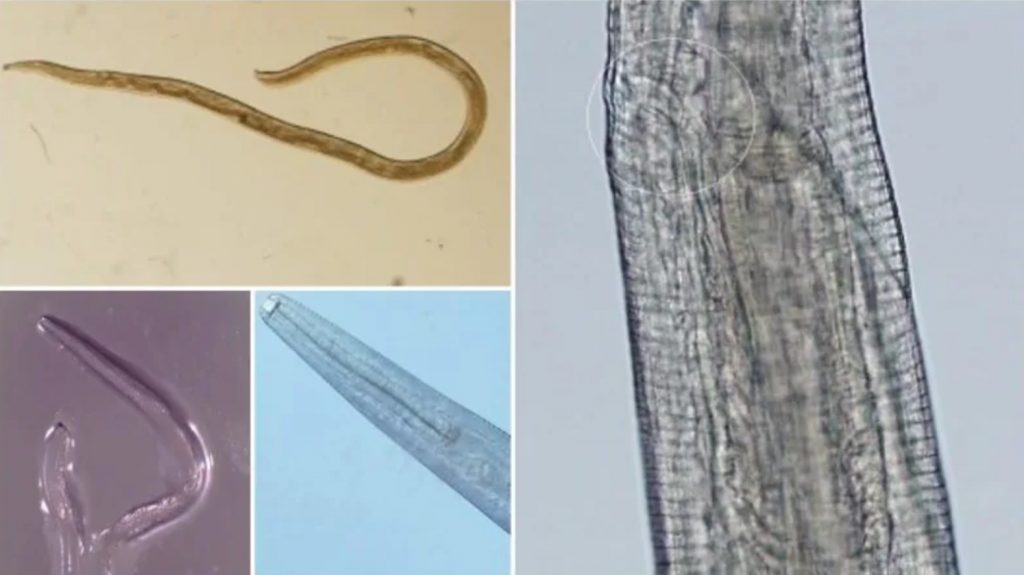A species of worm that can infect human eyes has done it again, and this time it chose a 68-year-old woman from Nebraska.
The woman is thought to be only the second human victim of these worms ever documented. But the incident signals they could become an emerging parasitic disease in the U.S.

The disturbing details of the case were laid out in a paper published this October. The woman’s doctors, as well as researchers from the Centers for Disease Control and Prevention, contributed to the paper.
According to the report, Dianne Travers-Gustafson, a medical anthropologist from Creighton University in Nebraska, was visiting California in February 2018.
One day, as she was running along a trail, she went straight into a swarm of flies. Unbeknownst to her, she had likely run into a particular kind of fly known as the face fly, or Musca autumnalis.
That’s because, a month later, an irritation in her right eye led her to the horrifying discovery of a tiny translucent roundworm, no longer than a half-inch in size.
“The patient had run into so many flies at once that she could not shoo them all away before one expelled larvae onto her eye.”
The vector fly will expel larvae onto the surface of the eye or the conjunctiva while feeding on lacrimal secretions (tears, etc.). This can happen very quickly, so the fly would not have had to sit on the eye for more than a few seconds to expel the larvae.
Normally people would shoo any flies near their eyes away before they could do this, but in this case, the patient had run into so many flies at once that she could not shoo them all away before one expelled larvae onto her eye.
Travers-Gustafson washed out the worm with tap water. Soon, though, she found and extracted a second one. A visit to the ophthalmologist the day after then yielded a third wiggler.
Weeks later, she had returned home to Nebraska but continued to experience inflammation in both eyes. A subsequent visit to another ophthalmologist turned up nothing, but lo and behold, she eventually pulled out a fourth worm.
Thankfully, that was seemingly the last hitchhiker, as her eyes quickly returned to normal afterward, and she even went on to help co-author the case report.
What Are These Parasitic Worms?
Scientiss discovered it is a member of the species Thelazia gulosa, better known as the cattle eye worm. Scarier still, it was an adult female worm, complete with a full cache of “eggs containing developed larvae.”
In other words, we—and the surface of our eyes—seem to be perfectly suitable hosts for them.
These larvae can only complete their life cycle and become adults if they’re picked up anew by face flies and are spat back into another animal’s eyes. So there’s no danger of having your eyes become a breeding ground for generations upon generations of these worms.
Only one other Infection Case
Travers-Gustafson isn’t the only person to have suffered this ignoble infection. In 2016, an Oregon woman ended up playing mom to a whopping 14 cattle eye worms, which made her the first person known to be infected by this particular species .
And while both women escaped with nothing more than a very scary story to share, the authors noted that in animals, these infections can cause permanent eye damage, even blindness, if left untreated.
Species of Thelazia are known to infect our eyes, thankfully only rarely. But up until last year, T. gulosa had never been fingered as a potential culprit for infection.
And the fact that these two infections have been documented so close together in time suggests that this could become a relatively rare but established trend, the authors noted.
“While it may just be a ‘fluke’ event that two cases have occurred within a year or two of each other, it does raise the possibility that something might have changed in the ecology of T. gulosa in the USA to cause it to start occasionally infecting humans,” Bradbury said.
So What’s Going Out Of Control?
It’s possible, for instance, that the species (and the flies that spread them) are now spreading far and wide among animal populations in the U.S., creating more opportunities for spillover transmission to people.
So, anyone who thinks they might have worms in their eye should go and see a qualified medical doctor for help. And the only real way to solve this very creepy mystery is to start tracking the prevalence of these infections among animal hosts across the country, as well as among face fly populations. [Gizmodo]













just like lice only nonblacks get it.